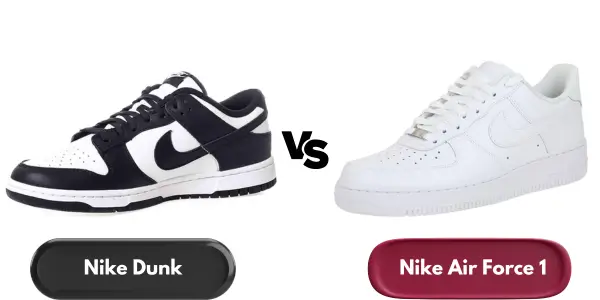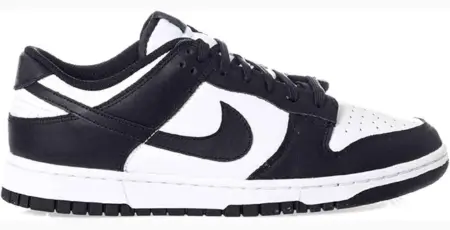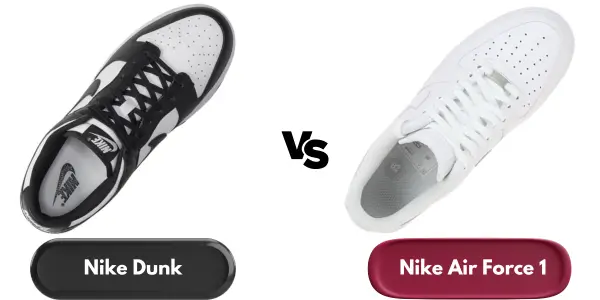Nike Dunks vs AF1 (Nike Air Force 1) Comparison
Last Updated: January 01, 2025 | Author: Jake Thompson
In the evolving landscape of sneaker culture, the rising popularity of Nike Dunks and Air Force 1s stands out, reflecting their iconic status and appeal. Both designs offer more than just aesthetics; they embody the blend of functionality and style that marks a true classic. The Dunks, with their roots in basketball and skateboarding, have surged in popularity through vibrant colorways and unique collaborations. Meanwhile, Air Force 1s maintain their relevance with timeless design and unmatched comfort, securing their place in both streetwear and sneaker aficionado circles.

As these models continue to dominate, they highlight the evolving preferences within the community, emphasizing a mix of heritage, innovation, and personal expression. In this article, we'll delve into a comparison of Nike Dunks vs AF1, exploring the elements that fuel their ongoing rivalry and the distinct qualities that make each stand out.
Table of Contents:
- Key Takeaways
- Table: Nike Dunks vs AF1
- Pros & Cons
- Midsole Technology
- Toe Box Design
- Performance
- Tread Pattern
- Comfort
- Cushioning & Support
- Ankle Support Features
- Durability
- Final Verdict
- Frequently Asked Questions
Key Takeaways
- - Air Technology and Midsole Differences: AF-1s have Nike Air technology in their midsoles for added comfort, while Dunks have a flat foam midsole.
- - Toe Box Design Differences: AF-1s have a rounded toe bumper with fewer perforations per row, while Dunks have a pronounced notch in the toe box where the foot bends.
- - Air Force 1 Toe Box Details: AF-1s have a unique toe box design with fewer perforations and a different shape.
- - Dunks Toe Box Details: Dunks have a distinctive toe box design with a pronounced notch and panels that connect to the eyestays at the forefoot.
Table: Nike Dunks vs AF1

|

|
|
|---|---|---|
| Feature | Nike Dunk | Air Force 1 |
| Design Inspiration | Basketball; low-cut and streamlined for performance. | Basketball; bulkier silhouette with a focus on durability and cushioning. |
| Upper Material | Varies (leather, suede, synthetic) offering durability and style flexibility. | Primarily leather, with variations in suede and synthetic, providing durability and a premium feel. |
| Sole Composition | Rubber outsole for traction and durability; thinner sole for ground feel. | Thick rubber sole with encapsulated Air-Sole unit for superior cushioning and impact absorption. |
| Cushioning | Standard insole cushioning; some models have Zoom Air units for responsive cushioning. | Air technology in the midsole for maximum cushioning and comfort. |
| Weight | Lighter due to its design and materials, enhancing movement and flexibility. | Heavier, due to its robust construction and cushioning technology. |
| Lacing System | Traditional lace-up closure for a secure fit. | Traditional lace-up closure with a variable width lacing system for a customizable fit. |
| Ankle Support | Low to mid-top versions for flexible ankle movement. | Higher cut in most models for increased ankle support. |
| Popular Variations | Dunk Low, Dunk High, SB Dunk (Skateboarding) with various collaborations. | AF1 Low, AF1 Mid, AF1 High, including special editions and collaborations. |
| Price |
Pros & Cons
Nike Dunks
Pros:- - Versatile for sports and skateboarding
- - More affordable
- - Wide range of colorways
- - True to size fit
- - Less cushioning without Air technology
- - Limited ankle support
- - Potential durability issues
Nike Air Force 1
Pros:- - Superior cushioning with Air technology
- - Durable construction
- - Better ankle support
- - Enhanced breathability
- - Higher price point
- - Bulkier design
- - Sizing can run large
Each sneaker's upper contributes to its iconic status, with the Dunks leaning towards a streamlined look and the AF1s favoring a more robust build.
Related: Best Nike Outdoor Basketball Shoes
Midsole Technology
Delving into the midsole technology, it's clear that Nike's Air Force 1s leverage their air encapsulated midsoles for superior comfort, setting them apart from the flat, foam-based midsoles of the Dunks.
This air technology, featuring air bubbles embedded within the sole, provides a responsive cushion that enhances the overall feel. The flexibility and pivot points of the AF1 are complemented by strategically placed flex grooves, ensuring smoother transitions and better traction.
In contrast, the Dunks, while reliable, lack the advanced cushioning system. Their sole is designed for a different purpose, focusing on ground contact and stability without the signature air bubbles. The absence of these elements in the Dunk's midsole results in a stark difference in underfoot experience.
Toe Box Design
Moving beyond the underlying cushioning systems, let's examine the toe box designs of the Nike Air Force 1s and Dunks, where subtle yet impactful differences define their unique aesthetics and fit.
Nike Air Force 1- - Rounded toe bumper, adding a classic and robust look
- - Generally fewer perforations per row for a cleaner facade
- - The spacious toe box allows for a comfortable fit, evoking a sense of ease
Nike Dunk
- - Sleek design with a pronounced notch at the toe, signifying agility
- - More perforations per row, which may imply superior breathability
- - A more streamlined toe box, catering to those who prefer a snugger fit
Analyzing these elements, it's clear that both the Nike Air Force 1 and the Dunk offer distinct experiences to their wearers.
Performance
When evaluating the performance of Nike Dunks vs Af 1s, the tread pattern plays a critical role.
AF1s feature a unique star pattern and concentric circles providing reliable grip, while Dunks offer angled flex grooves for better board feel in their SB line.
I'll analyze how these designs impact functionality and which shoe may offer superior traction and stability for specific activities.
Tread Pattern
Examining the tread patterns of both Dunks vs Air Force Ones reveals distinct design choices tailored to enhance performance in different settings. The Air Force 1s showcase concentric curves around the heel pivot, designed for smooth transitions. They also feature siped edging for increased grip and flexibility, as well as a distinctive star pattern for that nostalgic connection and improved traction.
Meanwhile, Nike Dunks feature a modified concentric curve design at the forefoot, integrating angled flex grooves for adaptability. They also have slanted tread lines at the heel, acting as an effective 'brake' during motion. Additionally, Nike Dunks have a coarser star pattern at the toe and medial forefoot, signifying the shoe's readiness for action.
These tread elements aren't just practical; they're a testament to the thoughtful engineering behind each pair.
Comfort
When it comes to comfort, the cushioning and support offered by a sneaker are pivotal.
I've found that the Air Force 1's air-cushioned midsoles provide a distinct advantage in terms of underfoot comfort compared to the Dunks' standard foam midsoles.
Furthermore, the design and fit of each model significantly influence their overall comfort levels, with the Air Force 1 typically offering more room in the toe box and better ankle support.
Cushioning & Support

In the realm of sneaker comfort, Nike's Air Force 1's air-cushioned midsoles offer a plush feel underfoot, setting them apart from the firmer, foam-based support of the Dunks.
Air Force 1s:- - Embrace the classic air-cushioned comfort that cradles the foot.
- - The iconic strap ensures secure ankle support, enhancing the overall stability.
- - A heel designed with concentric circles contributes to a grounded and balanced step.
Dunks:
- - Appreciate the responsive, foam-based cushioning lending itself to a firmer ride.
- - Lacking the ankle strap, they offer a more liberated range of motion.
- - The medial arch doesn't feature the same air technology but still provides a supportive structure.
Both models offer distinct cushioning & support, catering to diverse preferences and styles.
Ankle Support Features
Delving into the ankle support features, it's clear that both the Nike Air Force 1 and the Nike Dunk offer distinct approaches to providing stability around the ankle area. For instance, the high-top version of the AF1 includes a strap that is built into the ankle collar, which offers additional ankle support. Conversely, the Dunk's high-top variant doesn't include such a strap but rather relies on a well-constructed ankle collar and sometimes additional flaps.
Here's a comparative table highlighting key ankle support features:
| Feature | Air Force 1 (AF1) | Dunk |
|---|---|---|
| High-Top Design | Yes, with built-in strap for additional ankle support | Yes, relies on ankle collar construction |
| Ankle Collar | Padded and supportive | Padded, less rigid than AF1 |
| Heel Pivot Design | AIR technology with pronounced notch on the medial arch | Foam cushioning with forefoot ball and heel pivot |
| Medial Arch Notch | Small notch for enhanced fit | Pronounced notch where the foot bends |
| Strap Integration | Strap is built into design | No built-in strap, uses flaps for reinforcement |
Related: Adidas vs Nike Running Shoes
Durability
While considering the different ankle support features of Nike Dunks vs Air Forces, it's also crucial to examine their durability and how each model withstands regular wear and tear.
As a basketball shoe, the Nike Air Force 1s have a front edge with their air-encapsulated rubber midsoles, offering sustained cushioning that can take a beating. Here's how they stack up:
Durability Factors:- - Materials: Nike Dunks often utilize lighter materials, whereas Air Force 1s boast thicker leather, which may affect longevity.
- - Sole Composition: The Air Force 1's air technology could potentially outlast Dunks' standard foam soles.
- - Construction: Both sneakers are well-constructed, but the differences between the Nike models may lead to varying durability outcomes, particularly in high-stress areas.
Final Verdict
Choosing between Nike Dunks and Air Force 1s comes down to personal preference. If you're into a sporty, versatile look with plenty of color options and a snug fit, Dunks might be your go-to. They're especially favored by those into skateboarding or seeking a shoe that pairs well with active lifestyles. Meanwhile, if comfort, durability, and classic street style are your priorities, Air Force 1s, with their air-cushioned midsoles and robust build, offer a compelling choice. They're ideal for those who value all-day comfort and a sneaker that stands up to wear and tear. Both sneakers showcase Nike's innovation and style, so your final pick will reflect what matters most to you in a shoe: the sleek agility of Dunks or the cushioned durability of Air Force 1s.
Frequently Asked Questions
1. What is difference between Dunks and Air Forces?
Nike Dunks, often linked to skateboarding (Nike SB Dunk) and basketball, are designed with a focus on agility, featuring slanted eye stays and a small notch on the medial side for flexibility. Air Force 1s, known for their durability and comfort, incorporate air technology for cushioning, latitudinal rows along the sides, and a chunkier silhouette. Both iconic sneakers serve different preferences in style and functionality.
2. Can Nike Dunks be used for basketball like Air Force 1s?
Yes, but with distinctions. Nike Dunks, originally designed for basketball, have evolved with versions like the Nike SB Dunk tailored for skateboarding, featuring design tweaks for specific activities. Air Force 1s, with their air cushioning, provide more support and comfort, making them versatile for both casual wear and certain sports. However, modern basketball shoes may offer more specialized features for the court.
3. How did Nike Dunks and Air Force 1s impact sneaker culture?
Both shoes have significantly influenced sneaker culture since their introduction during the golden era of basketball. Nike Dunks have been celebrated for their versatility and style, transitioning from the basketball court to skate parks and street fashion. Air Force 1s have become a cultural icon, representing innovation with their air technology and a symbol of style beyond the basketball community.
4. What unique features make Nike Dunks and Air Force 1s stand out?
Nike Dunks are recognized for their performance-oriented design, including features like ball and heel pivot points for better control. They also sport a variety of colorways and collaborations. Air Force 1s stand out due to the air cushioning for enhanced comfort, a robust build for longevity, and a timeless aesthetic that has cemented them as a staple in sneaker collections worldwide.
5. How do Nike Air Force 1 compared to the Dunks in fit and design?
The Nike Dunks and Nike Air Force 1s, while both iconic Nike shoes, differ mainly in fit and design. Dunks offer a snugger fit, ideal for skateboarding, with a thinner sole and minimal tread pattern. Air Force 1s feature a roomier fit, thicker sole for more cushion, and a distinctive tread for better grip. Each style showcases unique elements like the lateral edge and throat line, catering to different preferences and uses.
Share this:







